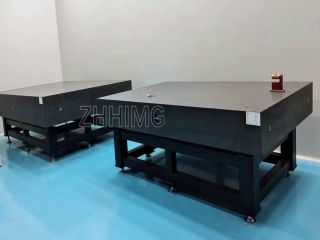In the field of optical instrument manufacturing, the precision of lenses directly determines the quality of the imaging. From astronomical telescopes to microscopic instruments, from high-end cameras to precision photolithography machines, the outstanding performance of every optical device relies on the support of high-precision lenses. Granite precision equipment, with its unparalleled characteristics, is becoming the key to creating high-precision lens grinding platforms, driving the manufacturing of optical instruments to a new level of precision.
The natural advantages of granite precision equipment
Granite was formed through geological processes over hundreds of millions of years and possesses unique physical properties, making it an ideal material for constructing high-precision lens grinding platforms. Firstly, the coefficient of thermal expansion of granite is extremely low, typically ranging from 5 to 7×10⁻⁶/℃, and it is almost unaffected by fluctuations in environmental temperature. During the lens grinding process, the heat generated by the equipment operation or the changes in environmental temperature will not cause significant deformation of the granite grinding platform, thus ensuring that the dimensional accuracy of the lenses remains stable throughout the grinding process and avoiding the curvature deviation of the lenses caused by thermal expansion and contraction.
Secondly, granite has excellent vibration damping performance. Optical lens grinding requires an extremely stable processing environment. Even the slightest vibration can cause defects on the lens surface. Granite can effectively absorb external vibration energy, reduce vibration interference during the grinding process, lower the vibration amplitude by 60% to 80%, ensure the precise relative position between the grinding tool and the lens, and help achieve ultra-high smoothness on the lens surface.
In addition, granite has high hardness and strong wear resistance, with a Mohs hardness of 6 to 7. In long-term and high-frequency lens grinding operations, granite grinding platforms are not prone to wear and tear, can always maintain stable precision, extend the service life of equipment, and reduce maintenance costs.
Precision processing technology of granite grinding platforms
To fully leverage the performance advantages of granite, the high-precision lens grinding platform adopts advanced technological processes during the manufacturing process. Through numerical control ultra-precision grinding and polishing technology, the surface flatness of the granite platform can be controlled within ±0.002mm/m, and the surface roughness can reach the nanometer level. This high-precision surface quality provides an accurate reference surface for lens grinding, ensuring that the grinding tools can process the lenses evenly and stably.
Meanwhile, in the design and manufacturing process of the granite grinding platform, precise mechanical structures and motion systems are combined. For instance, by integrating high-precision air-floating guide rails and servo motor drive systems, grinding tools can achieve smooth and precise movement on the platform, with a motion positioning accuracy of ±0.005mm. This high-precision motion control, combined with the stability of the granite platform, can meet the grinding requirements of complex curved surfaces for different types of lenses. Whether it is concave lenses, convex lenses, or aspheric lenses, high-precision processing can be achieved.
The industry value of granite precision equipment
Post time: May-07-2025

